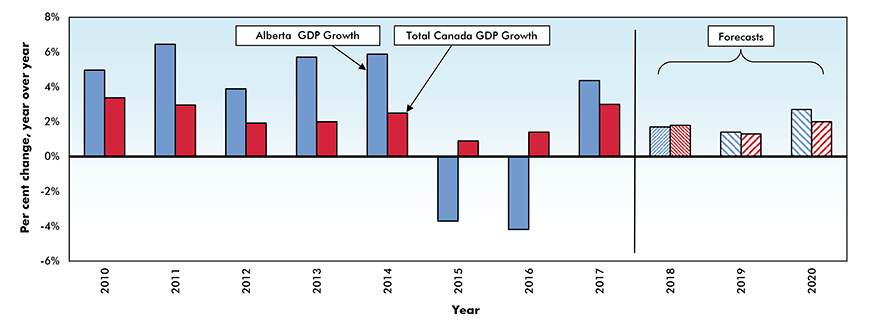After posting solid growth throughout most of 2018, the Alberta economy hit a speed bump in the final quarter of the year. This slowdown, triggered by a 40% drop in oil prices and exacerbated by a persisting lack of pipeline capacity, caused firms to put their hiring and investment plans on hold and consumers to postpone major purchases.
The impact of the drop in oil prices was particularly hard on the construction industry which, over the past four months, has shed 7,200 jobs on top of the 4,700 it lost during 2018.
Other industries which have seen significant staff cuts over the past four months include the hospitality industry, information services (includes IT) and health services. After hitting a three year low of 6.2% in November of last year, Alberta’s unemployment rate rose to 7.3% in February of this year, a 14-month high.
Although the weak job growth through 2018 and early this year depressed both consumer spending and residential construction through the first quarter, the solid 21,000 gain in April employment suggests firms are more optimistic about their future prospects. This optimism appears to be shared by consumers whose confidence, as reflected by the Conference Board’s Index of Consumer Confidence, increased by 9.1 points in April, taking it to its highest level since August of last year.
Slowing net migration and sagging employment growth over the past year have combined to cause sales of existing homes in Alberta to decline by 5.7% year to date, slightly more than the 5.1% ytd decline they exhibited in the first three months of 2018. As a result, house prices in the province are down by 3.2% ytd compared to a 1% ytd decline in the first three months of 2018.
Faced with this severe softening in demand and an unprecedented inventory of completed and unoccupied single, semi and row dwelling units, Alberta home builders scaled back construction of single- detached units by 29%, semi-detached units by 38% and row units by 9%. Reflecting the downtrend in the apartment vacancy rate over the past two years, starts of multiple units are up by 15%. Weighed down by the weak first quarter and the very large inventory of completed and unoccupied units, starts should total in the range of 24,000 to 25,000 units this year and 26,000 to 28,000 in 2020 due to the combination of stronger job growth and strengthening net migration. Starts totalled 26,100 in 2018.
Hobbled initially by low oil prices and subsequently by uncertainty regarding their ability to access international markets, firms in the energy sector will likely adopt a cautious approach to increasing their footprint in Alberta. According to Stats Canada’s latest Non-Residential Capital and Repair Expenditure Survey, planned energy investment in 2019 will decline by 4% for the second year in a row. As a result, total planned investment is projected to shrink by -1.3% after posting a slight 0.5% increase in 2018.
Looking ahead to 2020 and beyond, the outlook for capital spending in the province is brighter given the gradual improvement in oil prices since the beginning of the year together with the recent election of a government that has made a strong commitment to getting more Alberta oil to tidewater and to cutting the corporate income tax rate from 12 to 8 percent over the next four years. Further, the recent indications that the Canadian government is likely go forward with construction of the Trans Mountain oil pipeline will significantly brighten investor confidence in the province.
This more upbeat outlook for Alberta is reinforced by the CFIB’s last two Business Barometers which reported back-to- back gains in business confidence among the province’s small and medium sized firms. Also, as noted above, the Conference Board in Canada’s latest Index of Consumer Confidence for Alberta has trended higher since the beginning of the year, due to better employment prospects.
By mid-2019, we expect the Alberta economy will have regained most of the momentum it lost late last year. However, the impact of the weak start will likely cause growth for the year to average in the range of 1.2% to 1.6%, down from 1.7% in 2018. Assuming that oil prices continue to trend higher and the climate for energy investment in the province continues to brighten, it is easy to expect growth in the range of 2.5% to 3% in 2020.
John Clinkard has over 35 years’ experience as an economist in international, national and regional research and analysis with leading financial institutions and media outlets in Canada.
Real* Gross Domestic Product (GDP) Growth — Alberta vs Canada

Chart: ConstructConnect — CanaData.











Recent Comments
comments for this post are closed